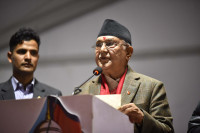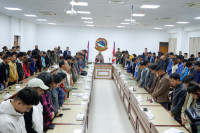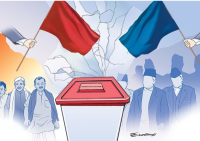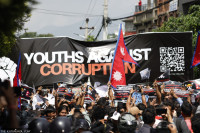Opinion
Breaking the silence
India has its own interest behind the blockade but why has the international community not spoken about it?
Jaya Lamichhane
When Nepal promulgated its new constitution, many countries welcomed it as a milestone, but our southern neighbour India only “noted” it. Nobody foresaw India’s ‘note’ as an indication of its intention to trigger a humanitarian crisis through a blockade in days to come. It is an irony that a country which calls itself the world’s largest democracy has questioned a sovereign country which has promulgated its constitution with the approval of more than 90 percent of its Constituent Assembly. To make matters worse, India even provided a list of amendments to Nepal’s constitution.
Hidden agenda
There is a popular proverb in Nepal about not seeing a buffalo on one’s body but noticing a louse on another person. This proverb best explains the behaviour of our neighbour. When India’s list of amendments was rejected outright, it resorted to a Cold War-era strategy of mounting an economic blockade by closing transit routes.
Nepal as a landlocked country has rights to trade and transport. But ironically, the same person who lectured on the HIT (hydropower, information technology and transportation) strategy of development in Nepal’s Parliament a year ago is now “hitting” the country by imposing a blockade, sending people to infiltrate the demonstrations and interfering in its neighbour’s internal politics.
The million dollar question is: What is the reason behind this? It’s not, as portrayed in the Indian media, about protecting the rights of minorities who have been demonstrating in parts of the Tarai. India will never want to do this as it can have a boomerang effect in terms of its own minorities and states. The reason behind this action is to control Nepal’s water resources. However, India’s game plan has been thwarted by the provision of citizenship rights in the constitution and the proposed demarcation of federal states. A pertinent question is how did these two things thwart the plan?
All about water
First, the citizenship provision in the constitution says that men can pass on their Nepali citizenship to their children, but women married to foreign nationals cannot do so and their children can become Nepalis only by naturalisation. The provision also states that naturalised citizens cannot assume high political and security offices. As there are many naturalised citizens in Nepal due to their close cultural relations in the Tarai, India wants them to reach the highest levels in politics, including the head of the proposed federal states and the security forces so that it can control Nepal’s water resources.
Second, in order to understand the relationship between water politics and the demarcation of the federal states in the Tarai, one has to have an understanding of Nepal’s three big rivers—Koshi, Karnali and Narayani (Gandaki). First, the Koshi lies in eastern Nepal and flows to northeast Bihar and eastern Mithila to join the Ganges. Second, the Karnali in far western Nepal flows southeast through Uttar Pradesh and Bihar to join the Ganges. Finally, the Narayani in central Nepal flows southeast across the Gangetic plains of Bihar state. The average water flow of the Koshi, Karnali and Narayani is 2,166, 2,990 and 1,760 cubic metres per second respectively. In comparison, the average water flow of the Nile River is 2,830 cubic metres per second.
Gaining control of these rivers means an uninterrupted supply of water for irrigation in Bihar and Uttar Pradesh during the low seasons and control of the upstream flow during the rainy season to protect these Indian states from floods. In addition, these river basins have a capacity to produce more than 25,000 MW of hydropower. India needs this water resource and power for its development and economic growth. Ideally, India wanted the entire Tarai to be a single state, and when this was not even considered, two states were proposed in the Tarai so that India could deal with these two states through which these rivers flow. However, the Nepali leadership smartly understood the game plan, and in order to maintain national integrity and equitable distribution of natural resources, they have demarcated the federal states in such a way that the six states are linked with the Tarai. With this federal structure, India’s dream of controlling the water resources through one or two states in the Tarai was shattered.
Furthermore, any compromise on the demarcation of states and citizenship rights in the constitution will be suicidal for Nepal’s national integrity, sovereignty and overall development, which is solely dependent on water and agricultural resources. There are some flaws in the constitution, and the government is ready to make the necessary amendments without affecting national sovereignty and integrity. There are some valid demands of some of the protestors, however, India’s interference and involvement by directly supporting and sending Indians to participate in the protests on Nepali soil has diluted these demonstrations.
Organised hypocrisy
It is shocking that the global community and advocates of rights have remained silent on this situation and no one except a few have dared to express a few words against India’s gross interference in Nepal. A majority of them have remained as mere spectators in this show of blockade in Nepal. Is the power of the Indian market the primary cause for this silence? The honest answer
is a yes as India is a huge market because of its growing economy and population. Thus, no one wants to antagonise India by raising the concerns of a small country, devastated by a massive earthquake and with a very small market economy.
This reminds me of another proverb in English which says that you must practice what you preach. Is the global community practicing what it is preaching? Not at all. Where are those voices for human rights, sovereign rights of landlocked countries, rights of development and the commitments and support for reconstruction at a time when Nepal needs them most? Isn’t it selfishness on the part of the world community to not speak on Nepal’s behalf? Is it possible to break the silence of the international community or will Nepal remain a lone warrior against the Indian blockade in this globalised world? If this is the fate the global community wants for a small landlocked country like Nepal, what is the use of all the treaties, conventions and advocacy of rights? Or are they intended to benefit only big countries like India? Breaking the silence of the international community can help Nepal recover quickly from the impact of the conflict and earthquake and proceed towards much awaited development with its new constitution.
Lamichhane is a public health specialist




 7.12°C Kathmandu
7.12°C Kathmandu










